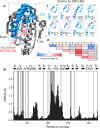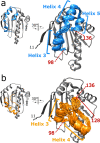Visualizing the transiently populated closed-state of human HSP90 ATP binding domain
- PMID: 36494347
- PMCID: PMC9734131
- DOI: 10.1038/s41467-022-35399-8
Visualizing the transiently populated closed-state of human HSP90 ATP binding domain
Abstract
HSP90 are abundant molecular chaperones, assisting the folding of several hundred client proteins, including substrates involved in tumor growth or neurodegenerative diseases. A complex set of large ATP-driven structural changes occurs during HSP90 functional cycle. However, the existence of such structural rearrangements in apo HSP90 has remained unclear. Here, we identify a metastable excited state in the isolated human HSP90α ATP binding domain. We use solution NMR and mutagenesis to characterize structures of both ground and excited states. We demonstrate that in solution the HSP90α ATP binding domain transiently samples a functionally relevant ATP-lid closed state, distant by more than 30 Å from the ground state. NMR relaxation enables to derive information on the kinetics and thermodynamics of this interconversion, while molecular dynamics simulations establish that the ATP-lid in closed conformation is a metastable exited state. The precise description of the dynamics and structures sampled by human HSP90α ATP binding domain provides information for the future design of new therapeutic ligands.
© 2022. The Author(s).
Conflict of interest statement
The authors declare no competing interests.
Figures






References
-
- Picard. HSP90 INTERACTORS Chaperones and relatives. Available at: http://www.picard.ch/downloads/Hsp90interactors.pdf (Accessed: 13th October 2021)
MeSH terms
Substances
Grants and funding
- ANR-15-IDEX-02/Agence Nationale de la Recherche (French National Research Agency)
- ANR-17-EURE-0003/Agence Nationale de la Recherche (French National Research Agency)
- ANR-10-INBS-05-02/Agence Nationale de la Recherche (French National Research Agency)
- pack ambition recherche 2019 - P089/Région Auvergne-Rhône-Alpes (Region Auvergne-Rhône-Alpes)
LinkOut - more resources
Full Text Sources

